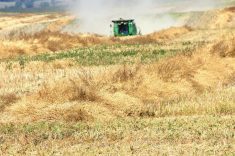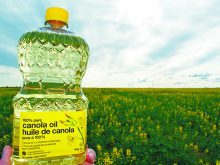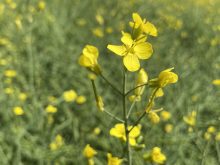Increasing the value of the crop’s various parts, rather than focusing just on seed, could be key to the sector’s prosperity
Glacier FarmMedia – It’s not enough for the canola industry to focus on seed. The next step of growth, according to one seed marketing expert, is about capturing more value for each of the plant’s parts.
”When we think about the whole value chain, we think about the farmer, we think about the crush partner, we think about the export market and we think about the consumer,” said April Nichol, seeds marketing leader with Corteva Canada, during the Canola Week event in early December.
“And what we really want is to create component demand that lets the market decide where canola production goes independent of year-to-year production (with its) peaks and valleys.”
Read Also

Huge Black Sea flax crop to provide stiff competition
Russia and Kazakhstan harvested huge flax crops and will be providing stiff competition in China and the EU.
That might include more protein content in the meal or greater oil content.
Canola meal already flows into the feed market, but canola meal protein projects could expand its portfolio. At the University of Saskatchewan, researchers are using it to feed microbes that could be used in food processing and precision fermentation. At the University of Manitoba, meal was one of the building blocks for a new bioplastic. It’s also being considered for new feed markets in aquaculture.
Oil content was an issue for Western Canada’s canola crops this year. Other Canola Week speakers from the Canadian Grain Commission noted that samples were 42.6 per cent oil, down from the 10-year average of 43.7. In general, oil content since 2021 has been below levels seen in the previous decade.
Industry needs to think about high-value components for both the domestic and export markets, Nichol said.
Canola oil, for example, can flow into both edible and renewable diesel markets, and the U.S. biofuel market has sparked considerable excitement from Canada’s canola industry.
It also means looking at canola seed as an oil and protein package that can be adapted for alternative markets, she said. Before that can happen, there must be better communication at various links in the value chain.
“We need supply, reliability, quantity, sustainable farm practices. These are among our assets,” said Nichol. “But we need better connectivity as we think about how we understand (what’s happening) from the farm to the downstream markets. Currently this connectivity is a bit weak.”
Improved connectivity would better enable the value chain to improve oil content and make canola meal a better feed fit for more animal species.
“And then, how do we think about a canola protein market in new markets like aquaculture? More importantly, can we use gene editing to influence commercialization and think about what the next 25 years looks like?”
Growing the fortunes of canola components must be anchored in production reality.
“First and foremost, yield and genetic gain are always going to drive grower profitability,” Nichol said. “We need to ensure canola maintains its place in the rotation as a high-end consistent (crop) so that we maintain our acreage.”
The Canadian canola industry also has limited ability to expand its acres, she added.
“We know today that we’re about 22 million acres. The whole market is basically built off of that. We don’t have opportunity to fluctuate that significantly without having huge implications on the value chain. We also know that seed oil percentage drives canola value and crush margin and it must be maintained.”
The economics of canola are driven by oil, Nichol noted, no matter how many byproduct markets open up.
“Oil and protein can be increased. Fibre can be reduced concurrently. And we also know that increasing protein does not need to (mean) expensive oil,” she said.
Increasing oil content depends primarily on the breeding side.
“On-farm agronomics, while they drive yield, they have limited opportunity to actually influence oil in the seed,” Nichol noted. “That needs to be done, really, by breeding for more oil in canola seed.
“When we think about canola seed, specifically every increase in oil, it has multiple benefits. It benefits the farmer from a price and market opportunity, but it also benefits our processors, our crush margin and our export markets.”
Breeding, therefore, should consider “the full package” and maintain what already works and is critical to the sector, while balancing the need for new opportunities.
“We can’t pinch-hit one thing over another. We can’t pick yield and reduce disease. We can’t pick genetic gain and reduce oil content. We have to do all of those things concurrently, and that truly is an interesting challenge,” she said.
“We also know that not all canola hybrids or germplasm have the same composition of oil, protein and fibre, so it’s critical that when we think about advancing canola hybrids, we have to advance and register canola hybrids based on well-established quality parameters — including foundational oil — and none of those things should be compromised.”
So what could canola be in the future? Corteva aims to improve canola meal. Nichol pointed to the company’s ProPound product, marketed with a protein content competitive with soybean meal.
“What we’re moving from is a canola oil crop that had a protein byproduct to a global oil and protein crop,” said Nichol.


















